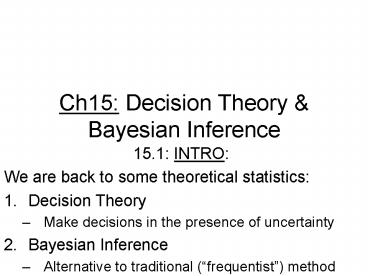Ch15: Decision Theory - PowerPoint PPT Presentation
1 / 12
Title:
Ch15: Decision Theory
Description:
15.2.1: Bayes & Minimax Rules 'good decision' with smaller risk. What If. To go around, use either a Minimax or a Bayes Rule: Minimax Rule: (minimize the maximum risk) ... – PowerPoint PPT presentation
Number of Views:23
Avg rating:3.0/5.0
Title: Ch15: Decision Theory
1
Ch15 Decision Theory Bayesian Inference
- 15.1 INTRO
- We are back to some theoretical statistics
- Decision Theory
- Make decisions in the presence of uncertainty
- Bayesian Inference
- Alternative to traditional (frequentist) method
2
15.2 Decision Theory
- New Terminology
- (true) state of nature parameter
- action choice based on the
observation of data, or a random variable, X,
whose CDF depends on - (statistical) decision function
- loss function
- risk function expected loss
3
Example Game Theory
- A Manager of oil Company vs B Opponent
(Nature) - Situation Is there any oil at a given location?
- Each of the players A and B has the choice of 2
moves - A has the choice between actions
to continue or to stop drilling - B controls the choice between parameters
whether there is oil or not.
4
15.2.1 Bayes Minimax Rules good decision
with smaller risk
- What If
- To go around, use either a Minimax or a Bayes
Rule - Minimax Rule (minimize the maximum risk)
- Bayes Rule (minimize the Bayes risk)
5
Classical Stat. vs Bayesian Stat.
- Classical (or Frequentist) Unknown but fixed
parameters to be estimated from the data. - ? ?
- Bayesian Parameters are random variables.
- Data and prior are combined to estimate
posterior. - The same picture as above with some
Inference and/or Prediction
Model
Data
Prior Information
6
15.2.2 Posterior Analysis
- Bayesians look at the parameter as a random
variable with prior distn and a
posterior distribution
7
15.2.3 Classification Hypothesis Testing
- Wish classify an element as belonging to one of
the classes partitioning a population of
interest. - e.g. an utterance will be classified by a
computer as one of the words in its dictionary
via sound measurements. - Hypothesis testing can be seen as a
classification matter with a constraint on the
probability of misclassification (the probability
of type I error).
8
15.2.4 Estimation
9
15.2.4 Estimation (example)
10
15.3.1 Bayesian Inference for the Normal
Distribution
11
How is the prior distribution altered by a random
sample ?
12
15.3.2 The Beta Distn is a conjugate prior to
the Binomial































